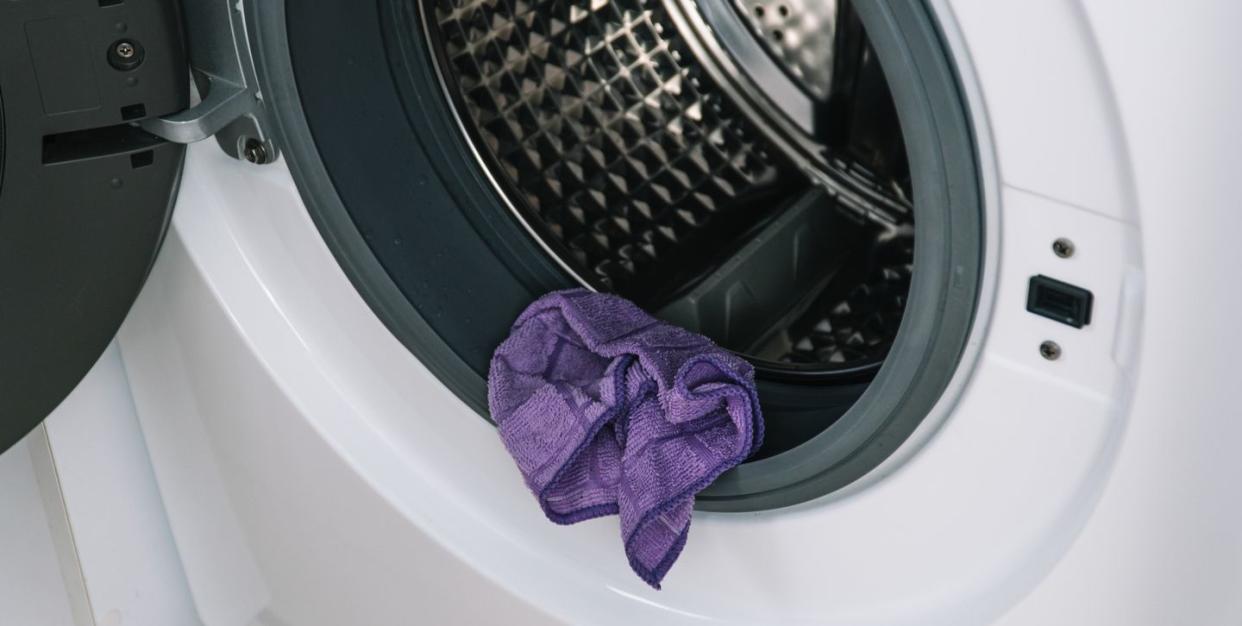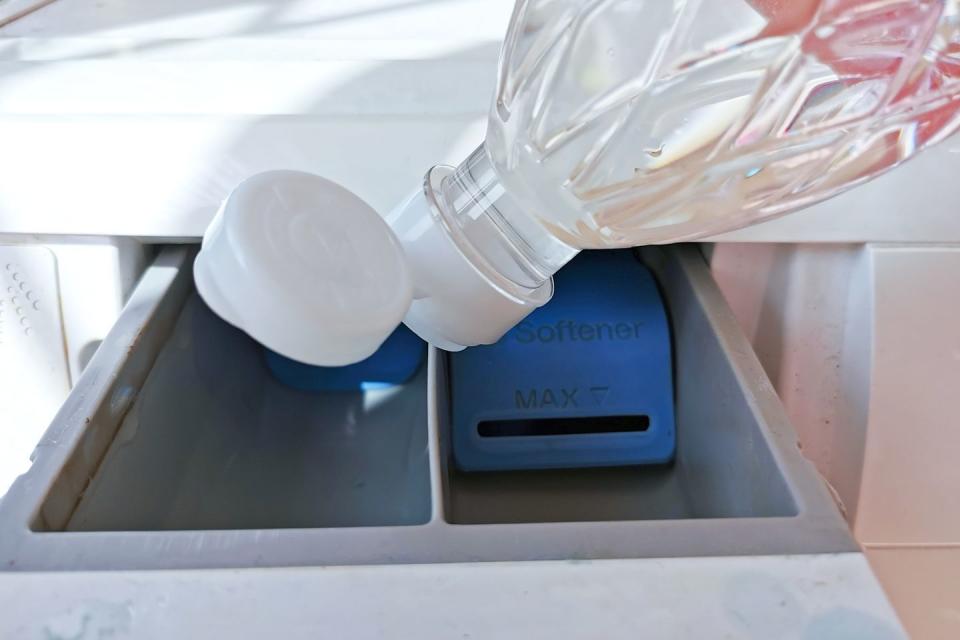A Step-by-Step Guide to Cleaning a Washing Machine

"Hearst Magazines and Yahoo may earn commission or revenue on some items through the links below."
Although most modern washing machines are as easy as “load, press a few buttons and off your clothes go,” there’s actually quite a bit of science and physical work happening inside the drum to ensure your clothes are getting as clean as they should.
Washing machines are one of the most frequently used appliances if you’re lucky enough to own one. As the useful machine drum turns and rolls away the dirt and grime that’s found its way onto your garments, all of that debris has to go somewhere. The only problem? Not all of it drains away through the standard cycle, leaving behind dirt on your freshly “cleaned” clothes — and that’s exactly why cleaning your washing machine is so important.
According to Marilee Nelson, co-founder of Branch Basics and consumer chemicals expert, “If you don’t regularly clean your washing machines, you’ll experience a major build-up of detergent, minerals and/or mold and mildew in your machine — all of which limit its cleaning capabilities.”
Like most household maintenance chores, a washing machine cleaning is best when done on a regular basis, making the process that much easier and less taxing to maintain. Considering washing machines now cost anywhere from $400 to more than $2,000, it’s worth taking the time and putting in the effort to really understand how to properly clean one. You might even find your clothes cleaner and brighter because of it!
How Often Should Your Clean Your Washing Machine?
The first step is simple: Read your owner’s manual. Typically, the manufacturer will tell you how often to run a self-clean cycle (if your washing machine has one) or if there’s a general rule for cleaning intervals.
If your owner’s manual doesn’t offer any solid guidance — don’t worry, we’re here to help. Start by planning to clean your washing machine once a month. If you’re frequently running heavily soiled loads, it may be wise to clean it more often, especially if you notice inefficiencies or less clean clothes. (Signs to look out for include residue on the drum after a load, less effective stain removal, bad odors, and abnormal run times.) In any case, always remember to leave your washing machine door open for at least 12 hours after a wash to let the drum area and gasket naturally dry to avoid mold from potentially growing inside of the gasket lining.
Which Items Do You Need to Clean Your Washing Machine?
Many companies will try to sell you a range of products, such as wipes and detergents, that claim to clean your washing machine — and while they might indeed be effective, the additives in these formulas are terrible for the environment (three popular products got very low scores from the Environmental Working Group).
Nelson says, “We highly recommend not using bleach when you clean your washing machine because it’s classified as a pesticide under the Federal Hazardous Substances Act. It’s also a lung and skin irritant, asthmagen, a carcinogen. Worst of all, it’s involved in more household poisonings than any other chemical!” So what should you use to clean your washing machine? It turns out that all you need to have on hand for a great (and environmentally-responsible) clean is plain distilled white vinegar.

Not only will vinegar thoroughly clean a washing machine in regular water environments, but in areas with hard water, it helps descale and reduce mineral deposits brought on by tough water, which ultimately will protect your clothes and allow them to last longer.
It’s important to remember that anything you run in your washing machine has a direct path to your local waterways, so it’s crucial to run as few chemicals as possible each time you run a load. Using a natural cleaning agent is the first step, then think about switching to a clothes cleaner with fewer chemicals and additives, such as Molly's Suds Unscented Laundry Detergent Powder, Seventh Generation Concentrated Laundry Detergent, and Washing Machine Cleaner & Deodorizer by Grove.
How to Clean a Top-Load Washing Machine
Cleaning a top-load washing machine is as easy as this three-step process, according to Nelson.
Fill with hot water, add 1 gallon of vinegar, and run for 10 minutes.
Turn off the washing machine and let the solution stand overnight.
In the morning, run your washing machine through a complete cycle.
Allowing the vinegar mix to sit overnight gives the solution time to really work its way through the washing machine, then the morning cycle will rinse out anything it picked up.
How to Clean a Front-Load Washing Machine
Front-loading and high-efficiency machines have the luxury of not needing a full night’s soak, Nelson advises. All you’ll need to do is run one gallon of distilled white vinegar through a full hot water wash cycle with no detergent or use the self-clean cycle.
Cleaning a Front-load Machine’s Gasket and Detergent Drawer
These are two areas that are especially prone to all sorts of unwanted buildup if they’re not properly maintained and cleaned. Both are pretty simple to clean and will certainly prolong the life of your machine if regularly managed. If you do find buildup or mold growth has occurred, then Nelson suggests taking the following steps:
For a front-loader gasket:
Pull back the gasket.
Spray with Branch Basics Bathroom Cleaner (or another plant-based cleaner, such as Puracy Natural Surface Cleaner) liberally.
Let sit for a couple of minutes.
Dip a microfiber or scrubbing brush in hot water and scrub the sprayed area under the gasket.
Use a damp or dry microfiber cloth for the final wipe.
Next, spray the drum and seal with distilled white vinegar, wait 5 minutes, scrub, and wipe with a damp microfiber cloth. Follow the same procedure with 3% hydrogen peroxide. If necessary, repeat the entire process until no mold issue remains.
For a front-loader detergent drawer:
Remove the entire detergent drawer.
Wipe out the empty cavity with a microfiber cloth sprayed with Branch Basics All Purpose (or another plant-based cleaner, such as Puracy Natural Surface Cleaner).
Spray the drawer with the plant-based cleaner of choice.
Use an old toothbrush or scrub brush to clean thoroughly.
Wash and rinse with warm water.
Dry cavity and drawer.
Return drawer to the washing machine.
Overall, these cleaning steps are fairly easy and don’t take up too much time — and they’ll certainly make a difference in the lifespan and quality of your washing machine in the long run. Cleaning a washing machine is an easy way to ensure you’re protecting your pricey laundry investment, as well as your wardrobe and linens too.
You Might Also Like

